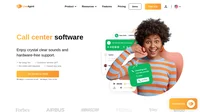What is the resolution time in help desk?
The resolution time in help desk refers to the time it takes for a support representative to solve a ticket from the moment it is reported until it is closed. It is a critical metric to measure the efficiency and effectiveness of support teams and systems.
Resolution time is different from response time, which measures the average amount of time it takes for a customer support team to respond to a customer’s initial message or inquiry. While response time focuses on the speed of the first response, resolution time measures the overall time it takes for the customer’s issue to be fully resolved.
Lowering the average resolution time is essential for businesses to provide efficient and effective customer service. Customers have high expectations for fast and helpful support, so tracking and improving resolution time is crucial. To achieve this, businesses can automate simple and repetitive inquiries to free up time for agents to focus on more complex and high-impact issues.
Different support channels, such as email, SMS, live chat, phone, and social media, may have different expectations for resolution time. Therefore, businesses should set service-level agreements (SLAs) accordingly. The ultimate goal is to efficiently and completely solve the customer’s issue, so an omnichannel strategy and a customer service platform that reduces platform-switching for agents are recommended.
Measuring resolution time has its pros and cons, but it is an important metric for help desk performance. By accurately measuring resolution time, businesses can identify areas for improvement and implement strategies to reduce resolution time. This can lead to better customer satisfaction, increased revenue, and improved business outcomes.
How to enhance efficiency and reduce resolution time?
A help desk ticketing tool can be a powerful asset for businesses looking to improve resolution time and enhance customer support efficiency. By using automation rules, tickets can be automatically resolved after a specific time of inactivity, allowing support agents to focus on active tickets and urgent issues. With the ticket history and customer information available in the help desk ticketing tool, agents can respond faster to inquiries, reducing the overall resolution time.
Resolution metrics are key in measuring and improving customer support efficiency. By tracking resolution metrics, businesses can identify areas for improvement and make necessary changes. Tracking resolution time and response time can help drive better customer service outcomes. Improved resolution metrics lead to higher customer satisfaction and loyalty.
Overall, the structured and organized nature of the help desk ticketing tool enables businesses to handle customer tickets more effectively and provide timely solutions, resulting in increased customer satisfaction and improved experience.
Frequently Asked Questions
What is call center resolution time?
Call center resolution time refers to the amount of time it takes for a call center to resolve a customer's issue or inquiry. It is an important metric for evaluating the effectiveness in addressing customer needs. It can be measured in minutes, hours, or days, and is often used as a key performance indicator for call center management.
What is Resolution Time?
Resolution time is the time from the customer's request until the case is fully resolved when the agent presses the Resolve button (sometimes this can be automatically resolved by a rule running in the background).
How can you calculate Resolution Time?
To calculate your solution time, divide the total time for all calls by the number of requests processed.
How to improve Resolution Time?
In order to improve the solution time, first of all, ensure quality customer service. Both agents should be properly prepared for their work and should have the right tools to assist in their work. Thanks to LiveAgent software, work can be automated, the agent can manage all communication channels from one place, and has access to reports.
What is the resolution of tickets within SLA?
The resolution of tickets within SLA refers to resolving customer issues or requests within the agreed-upon timeframe set by the service level agreement (SLA). This metric gauges how effectively and promptly a support team addresses and closes tickets, ensuring they meet or exceed the expectations set in the SLA. Achieving a high percentage of tickets resolved within the SLA indicates strong performance and contributes to customer satisfaction. Conversely, consistently missing SLA targets may highlight areas for improvement in the support process.
After learning about resolution time, you might be curious about how to handle a resolved ticket. This will help you understand the difference between closed and resolved tickets, and how to manage them effectively. Additionally, exploring first call resolution can offer insights into improving customer service through efficient call handling. Discover the benefits and best practices to enhance your customer interactions.
Provide excellent customer service
Discover unparalleled customer support with LiveAgent's all-in-one software. Benefit from 24/7 service, a free trial without a credit card, and seamless integration across 130+ ticketing features. Enhance your business with fast setup, AI assistance, live chat, and more. Choose LiveAgent for exceptional service and satisfied customers.

 Български
Български  Čeština
Čeština  Dansk
Dansk  Deutsch
Deutsch  Eesti
Eesti  Español
Español  Français
Français  Ελληνικα
Ελληνικα  Hrvatski
Hrvatski  Italiano
Italiano  Latviešu
Latviešu  Lietuviškai
Lietuviškai  Magyar
Magyar  Nederlands
Nederlands  Norsk bokmål
Norsk bokmål  Polski
Polski  Română
Română  Русский
Русский  Slovenčina
Slovenčina  Slovenščina
Slovenščina  简体中文
简体中文  Tagalog
Tagalog  Tiếng Việt
Tiếng Việt  العربية
العربية  Português
Português 




